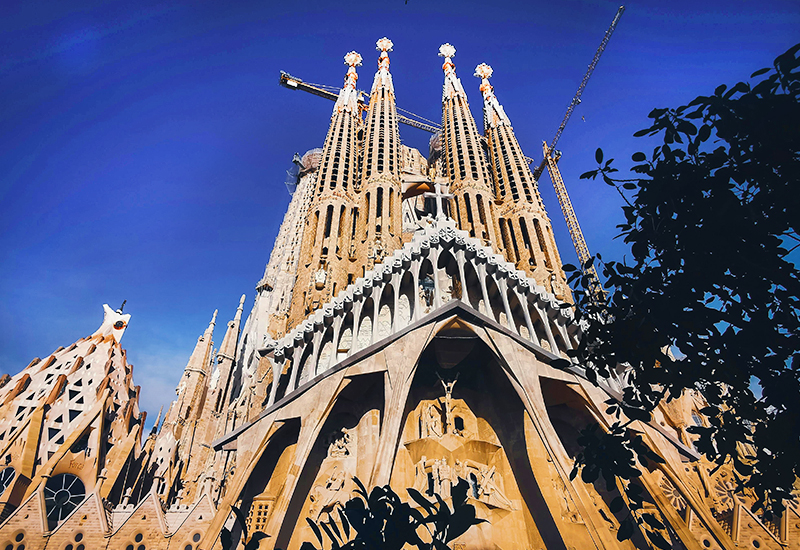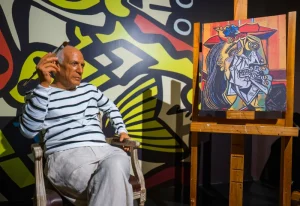The Basilica de la Sagrada Familia is a large Roman Catholic Church in Barcelona, Catalonia, and is considered one of the most beautiful sights in Europe. This church was designed by the Catalan architect Antoni Gaudi (1852–1926). The construction of the Sagrada Familia Church is incomplete, but it is considered a UNESCO World Heritage site and was declared a minor basilica by Pope Benedict XVI in November 2010.
To learn more about the history and location of the Basilica de la Sagrada Familia, read this article from the Spain travel guide to the end.
Table of Contents
ToggleAbout Sagrada Familia
Construction of the Basilica de la Sagrada Familia began in 1882, and Gaudi joined the project in 1883, transforming it with his architectural and engineering style—a combination of Gothic forms and Art Nouveau forms.
Gaudi spent the last years of his life on the project, and by the time of his death in 1926, less than a quarter of the project had been completed.
The construction of Sagrada Familia progressed slowly, as it relied on private donations, and the construction of the church was halted when the Spanish Civil War broke out.
Sagrada Familia History
A bookseller named “Josep Maria Bocabella” traveled to the Vatican in 1872, and after returning from Italy, he proposed the idea of building a church inspired by the Basilica of Loreto in Italy.
An architect named “Francisco de Paula del Villar,” who planned the revival of the Gothic church, drew the initial plan, and construction of the church’s altar began on March 19, 1882, in honor of St. Joseph.
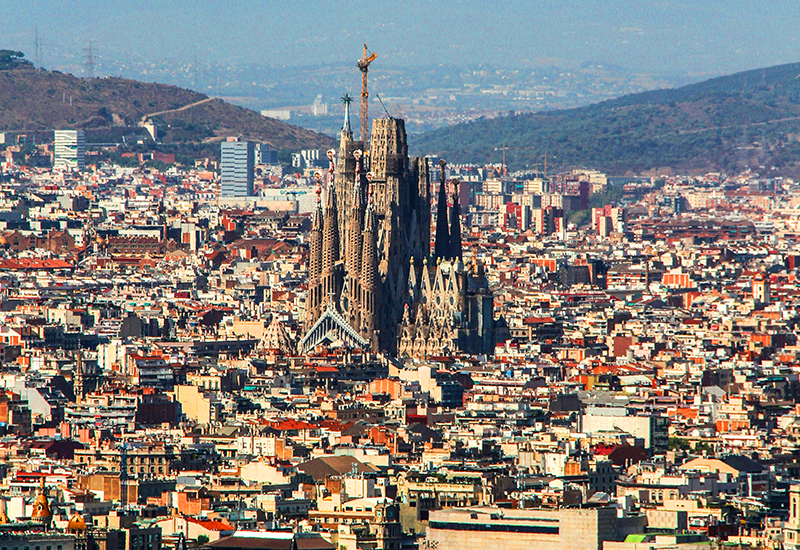
The construction of the church’s altar was completed on March 18, 1882, before the resignation of Francisco del Villar. After that, in 1883, Antoni Gaudi took over the responsibility of designing the church and made fundamental changes to it.
The construction of the Sagrada Familia church took a long time. In response to complaints about the long construction process, Gaudi remarked that his visitors were not in a hurry.
When Gaudi died in 1926, only 20 to 25 percent of the Sagrada Familia was completed. After Gaudi’s death, the construction of the church continued under the supervision of his student until the Spanish Civil War broke out in 1936.
During the Civil War, parts of the unfinished church were destroyed, along with Gaudi’s models and workshop. The current design of the church is actually a reconstructed version of the designs that were destroyed in the fire.
Sagrada Familia Facts
The Basilica de la Sagrada Familia’s architectural style combines Spanish Gothic architecture, Catalan Modernism, and Art Nouveau. Gaudi used the modern art of his time to decorate the surface of the building.

From the very beginning, this church was designed in the same dimensions as the cathedral. The overall layout of the church closely resembles the layout of other Spanish cathedrals like Burgos Cathedral, Leon Cathedral, and Seville Cathedral.
Just like other Gothic and European cathedrals, the Sagrada Familia church has a relatively short height compared to its width and has complex sections. These include two aisles, an ambulatory with seven small chapels, numerous towers, and three vastly different and elaborately decorated portals.
Sagrada Familia Church has a special design; A rectangular covered portico surrounds the church and includes all three entrances. There are almost no right angles inside or outside the church and few straight lines in its design.
Sagrada Familia in Barcelona Towers
In Gaudi’s design, a total of 18 towers were considered for the church: 12 towers for the apostles of Jesus Christ, four towers for the evangelists, one tower for the Holy Mary, and the tallest tower for Jesus Christ.
By 2023, 13 towers, including eight towers of the apostles, four towers of the evangelists, and the tower of the Holy Mary, will be completed.
At the top of the evangelists’ towers, a statue of their traditional symbols has been placed, which are a winged ox for Luke, a winged man for Matthew, an eagle for John, and a winged lion for Mark.
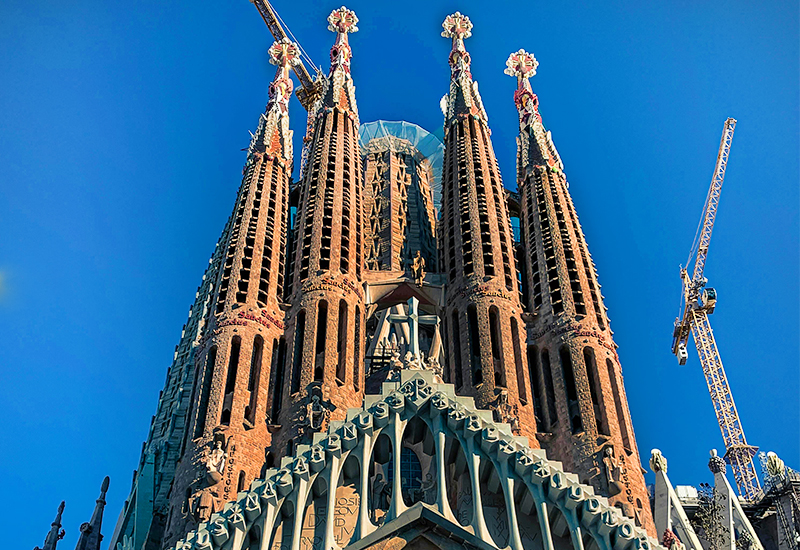
The central tower of Jesus Christ is planned to be 172.5 meters tall, topped with a large cross. Gaudi intended for tubular bells powered by the wind to be installed in the towers, creating sound throughout the church. He conducted acoustic studies to achieve optimal sound within the basilica. Currently, only one bell has been installed.
With the completion of the Tower of Jesus Christ, the Sagrada Familia Church will become the tallest church in the world; in that case, it will be 11 meters higher than the Ulm Minster, which is 161.5 meters high. In the construction of the Basilica de la Sagrada Familia, the parts are assembled in advance and then added to the main building, which has significant operational advantages in the speed of construction and the strength of the building.
Basilica de la Sagrada Familia Inside
The plan of the church is a Latin cross with five aisles. The vaults of the central nave reach 45, and the vaults of the side aisles reach thirty meters.
The transept has three aisles. Its columns are located on a 7.5-meter grid. Yet the apse columns, as positioned in Villar’s plan, do not connect to the grid, necessitating some of the pedestal columns to be moved to the grid, resulting in a horseshoe pattern in the design of those columns.
The intersection rests on four central porphyry columns made of a large hyperboloid surrounded by two rings of twelve hyperboloids (currently under construction).
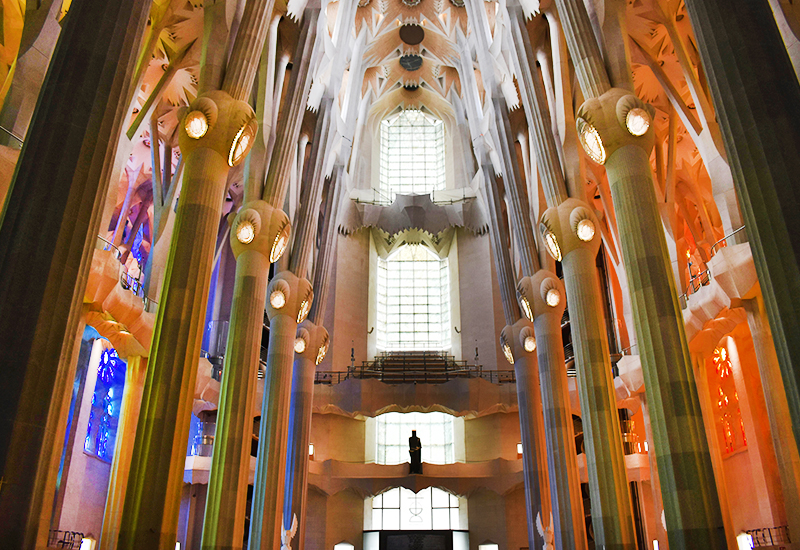
The central vault reaches sixty meters. This apse is covered with a seventy-five-meter-high hyperboloid arch. Gaudi intended to aim at the main entrance to see the vaults of the nave.
Golden Elements of Sagrada Familia Spain
Gaudi always wished to remove the defects of Gothic architecture; that’s why he decided to combine his new architectural style with the Gothic model and eliminate its defects. This is also why the complexity of this architecture is still not fully understood by many contemporary architects. He has used light creatively so that the tips of the towers shine with light.
Watching the sunrise next to this church makes you smile because the architectural form and the shine of the sunlight on it is such that it gives more shine and glory to this church, and psychologically, it evokes its sanctity in the mind.
Basilica de la Sagrada Familia Ticket
In 2024, a visit to the Basilica de la Sagrada Familia in Barcelona includes the following ticket prices. For a basic entry without a guide, the cost is 26 euros, while a guided tour increases the price to 30 euros.
Seniors can visit for 21 euros without a guide or 23 euros with a guide. For people under 30 and students, tickets cost 24 euros without a guide and 28 euros with a guide.
Children under 11 and people with disabilities can enter for free, and their companions can join for free without a guide or for €4 with a guide.
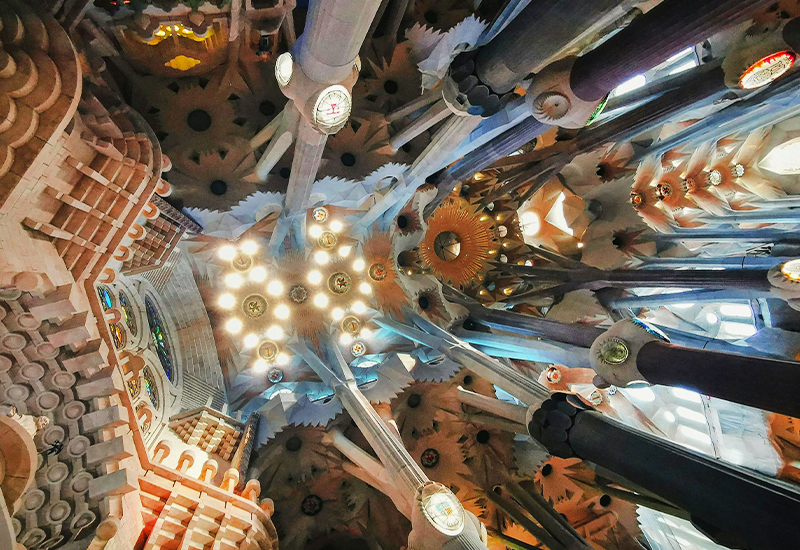
Prices go up if you want to include a visit to the towers: general admission costs €36 without a guide and €40 with a guide. Seniors pay 28 euros without a guide and 32 euros with a guide.
People under 30 and students can access the towers for 34 euros without a guide and 38 euros with a guide. Children under 11 and people with disabilities also have free access to the towers, while their companions pay €10 without a guide and €14 with one.
Sagrada Familia Completion Date
The Basilica de la Sagrada Familia in Barcelona, designed by Antoni Gaudi, has been under construction since 1882. The completion date has been delayed multiple times, and current projections aim for a finish around 2026, marking the centenary of Gaudi’s death.
Final Word
The Basilica de la Sagrada Familia, with its elevated stature, will inspire the viewer with the height of grandeur. This church is still under renovation after 130 years. Maybe this structure is half finished, but it attracts about 2.8 million people every year and is considered the most visited historical monument in Spain.
The Basilica de la Sagrada Familia church will amaze and even shock you, not only because of its insane size but more because of its extraordinary and unique architectural style. The architecture of the Basilica de la Sagrada Familia shows the genius of the world architect Antoni Gaudi.
If you are planning a trip to Spain and the Catalan capital, Sagrada Familia is the first place you should visit during your stay in Barcelona.
If you want to experience a unique and exciting trip, make sure to visit Spain cities and towns.

